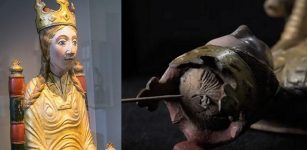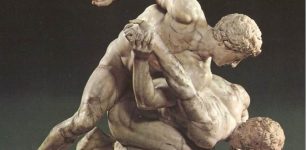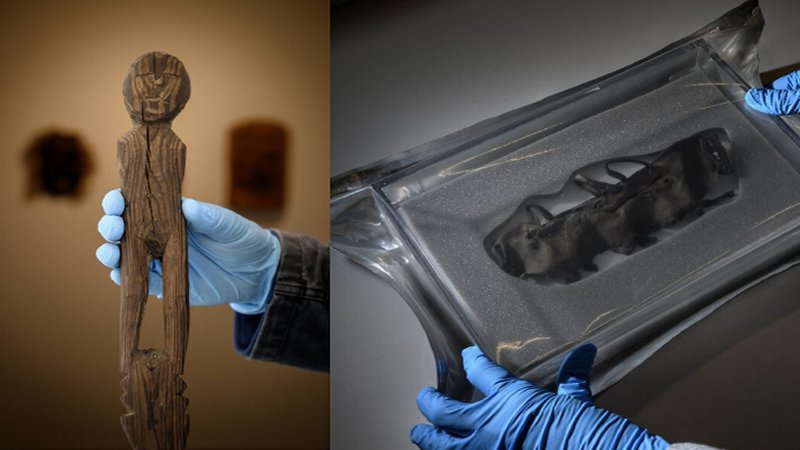Ivar The Boneless: Famous Viking And Son Of Ragnar Lodbrok
MessageToEagle.com – Ivar the Boneless was the son of Ragnar Lodbrok, the fearless Sea King. Of all of Ragnar’s children, Ivar the Boneless was the most enigmatic.
The reason why he was called Ivar the Boneless is not entirely clear and the Vikings themselves had contradictory legends about the meaning of his nickname. Some claimed that he was born completely without bones, but had supernatural strength and height, others that his legs had only gristle, forcing him to be carried into battle on a shield.
Ivar the Boneless took revenge for his father’s death and his cunning warrior abilities and conquests made him one of the most famous Vikings.
Ivar The Boneless Was A Deadly Killing Machine
It is very possible that Ivar the Boneless suffered from a benign hypermobility syndrome which results in the joints being very lose and flexible. This kind of degenerative bone disease meant that his legs were much weaker than the rest of his body.

According to most sources, he was often carried into battle on a giant shield by his men. The shield turned him into a deadly killing machine. It is known that his upper body was incredibly strong and he was lethally accurate with a long bow. He was a great Viking warrior despite the condition of his legs.
Ragnar Lodbrok Feared His Son Ivar The Boneless Would Become More Famous Than He Was
Ivar the Boneless’ father Ragnar Lodbrok was one of the most popular Norse heroes among the Vikings. As a legendary Viking commander who became a scourge of England and France, he is often referred to as a larger than life character. Ragnar Lodbrok’s life and adventures are described in the thirteenth century Icelandic Sagas Ragnar’s Tale and The Tale of Ragnar’s Sons.

It the Icelandic Sagas, Lodbrok it is also written that admitted his desire for fame and fortune was partly out of fear that his sons. He was especially concerned that his oldest son Ivar the Boneless would become more famous and popular than he was. This could also be the reason why Lodbrok did everything that was in his power to continue a number of successful raids against France throughout the mid ninth century, and fight numerous civil wars in Denmark.
Ivar The Boneless Was As Cunning As Cruel
Ivar the Boneless was remarkably cunning. As a Viking warrior he could also be very cruel, which he demonstrated when he took revenge for his father’s death and killed Aella.
In 865 Ivar the Boneless decided to invade England and launched the largest invasion of the British Isles in recorded history. Together with his brothers Halfdan and Ubba as well as his colleague Olaf the White Ivar the Boneless sailed from Dublin and landed in East Anglia.

The Viking forces met no opposition. Locals raised money to bride the Vikings away. Ivar the Boneless took their money, but had no intention of leaving. He had command of a force so massive that the English referred to it simply as “The Great Heathen Army”. It was a coalition of Norse warriors, originating from Denmark and Norway (and possibly also from Sweden) who came together under a unified command.
Ivar’s plan was to pick off the Anglo-Saxon kingdoms one by one and the Vikings stayed in East Anglia well into the next year, systematically stripping the surrounding countryside of its food.
When the autumn approached, Ivar the Boneless accepted brides and ordered his warriors to head for the kingdom of Northumbria. The Northumbrians had recently driven out their king and replaced him with a tyrant named Aella, the man who had allegedly killed Ragnar Lothbrok. Ivar the Boneless sought revenge for his father’s death.
Ivar Ordered Aella Subjected To The Dreaded ‘Blood-Eagle’ As A Sacrifice To Odin
The Vikings were well acquainted with the northernmost kingdom. The capital city of Northumbria Eforwic (York) was first captured on 1 November 866 when the city was busy celebrating All Saints Day. There was hardly any bloodshed because supposedly everyone was at church except for the Vikings. It was the Vikings who renamed the city Jorvik. Vik means a bay in Old Norse. The Romans called it Eboracum and the Anglo Saxons changed it to Eforwic.
Capturing the city had clear military benefits. York was a good strategic place that gave the Vikings access to multiple trading centers and made it possible to avoid the treacherous six-hundred mile sea route around the north of Scotland.

In the street fighting that followed, the English were wiped out and what was left of the royal court fled north to Scotland. When news of the Vikings’ arrival reached Aella, he simply fled, but was soon captured by the Norse warriors.
The Anglo-Saxon Chronicle merely states that ‘the kings of Northumbria were slain’, but the Norse sagas recount a more grisly end.
See also:
Mysterious Jomsvikings: Fearless Scandinavian Warrior-Brotherhood
Famous Viking Ragnar Lodbrok – Legendary Fearless Sea-King Of The North
Viking Ingvar The Far-Travelled And His Great Expedition To The East
Explore The Mysterious Ancient World Of The Vikings
Aella was captured alive and brought before Ivar who ordered that he be subjected to the dreaded ‘blood-eagle’ as a sacrifice to Odin. 56 The king was stripped to the waist and tied down to the ground. A Viking warrior hacked at his ribs, breaking them and cutting a deep incision down either side of the spine. The lungs were then pulled out through the wounds and allowed to quiver like a pair of blood-stained wings until the writhing king expired.
Safisfied with getting revenge for his father’s death, Ivar the Boneless returned to his Irish capital in triumph. He was now celebrated as the most famous Viking living, the greatest of the sea-kings. In 871 he took the unwieldy but impressive title ‘King of the Northmen of all Ireland and Britain”.
The Remains Of Ivar The Boneless
As Ragnar Lothbrok had long ago feared, Ivar had surpassed his father. Two years later he died peacefully. He had accomplished all he wished for. It’s not known where he died, but according to a legend, Ivar the Boneless wanted to be buried in England. His corpse was allegedly transported from Dublin and interred in English soil.
In the seventeenth century a grave was found in Repton containing the intact skeleton of a remarkably large man – supposedly nine feet tall – surrounded by the disarticulated remains of two hundred and fifty Vikings. Since it dates from the right time, and is clearly a figure of importance, some have speculated that the bones are – ironically given his nickname – the remains of Ivar the Boneless.
Copyright © MessageToEagle.com. All rights reserved. This material may not be published, broadcast, rewritten or redistributed in whole or part without the express written permission of MessageToEagle.com










